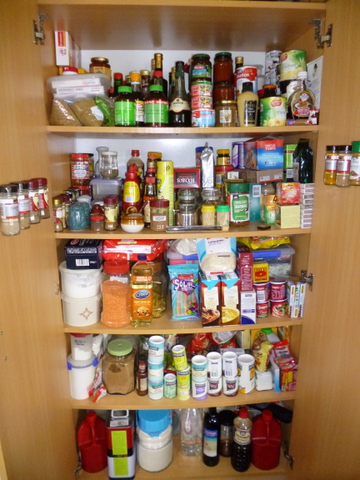Back in the 80s I did a lot of work with a local religious group, helping the members set up food storage systems, the idea being that they would end up with a year’s supply of food for their entire family. Another bloke and I would meet with people in their homes, work with them to tease out what they wanted and then put together a document (Food Storage List Form) that they could work with. The document is really a list of the things they wanted to get; we had a proforma drawn up that we could fill out and leave with them. I thought they had all gone but after some intensive searching I was able to find an old blank copy and you can download it here.
During the process we would discuss with the family all about the types of things they might want in their storage program and work through the process, it would take about 2 hours. During the process we would talk about the things covered in other articles in this section -
The process we would follow was basically this –
The first things we talked about were the basic stores (aka “the big four”) the idea being that if you had the required amount per person (i.e. wheat 140kg; honey or sugar 30kg; powdered milk 35kg and salt 3 kg) this would be enough to keep you alive for a year. In most cases the families we talked to already had some of these stores so it was just a case of multiplying the number of family members by the amounts required for the year and then subtracting the amount (if any) that they had on hand. The final figure was how much of each they needed to buy in. All of this was written down on the form.
Next we went through the tinned stuff – veggie, fruit and meat/fish. It basically came down to how many meals the family would want per week using that particular product. Work that back to the number of tins per week and multiply by 52 and then to get the “box equivalent” divide that number by 24. The box equivalent is basically the number of boxes of each particular type of tinned product. The box equivalent number was important when the family was looking at buying in bulk, so they could understand the number of boxes of each tinned product that was required to get them where they wanted to go. It also gave them some idea of the volume required to store the stuff.
There are other advantages to the “box as a whole” approach. The way we would do it is to buy a box of tins, then rather than pulling all the tins out and storing them somewhere then writing the purchase date on all the tins (critical for keeping track) we would just write the purchase date on the box. That way the oldest box of tins would go into an area for immediate use and the other fresher boxes remained in a storage area. Once that box was empty it would be replaced by the next oldest box and a new boxful of tins would be bought to replace the one used up. This prevents the problem of getting to a box of tins that is 10 years old and wondering if they are safe, or nutritious, to eat.
Anyway, that was the way the process worked, discuss each item on the list line by line and work out how much the family figured they would consume of each product in a year. This list is somewhat old of course and some things, like the tin sizes, have changed. A goodly proportion of the tins used to be 440 grams in weight as they are on the form, close to the old one pound tin, but nowadays they have revised it down to an even 400 grams (although I bet there was no corresponding reduction in price).
During this process we would also discuss places to store the food, the need to rotate your stocks to keep things fresh which is referred to these days as FIFO – first in, first out (not fly in, fly out!) as we did by the box (see above). Over a period of a couple of years we talked to over 50 families and greater than 50% of them used the process to improve their food storage programs.




